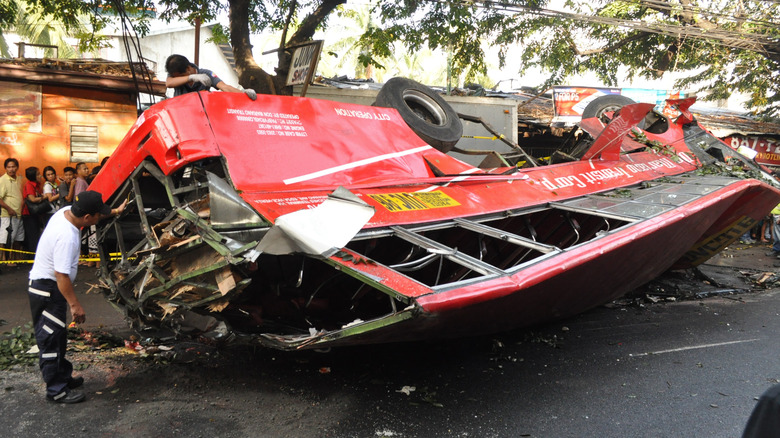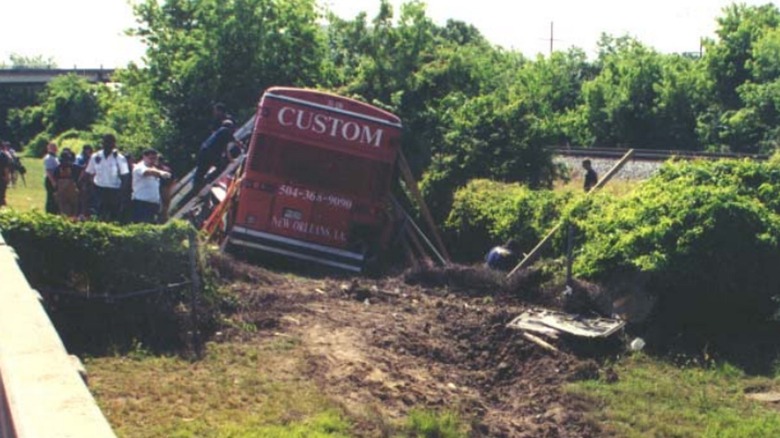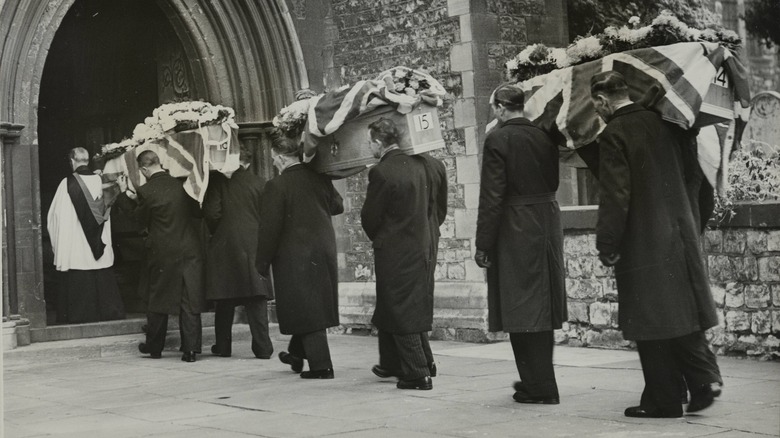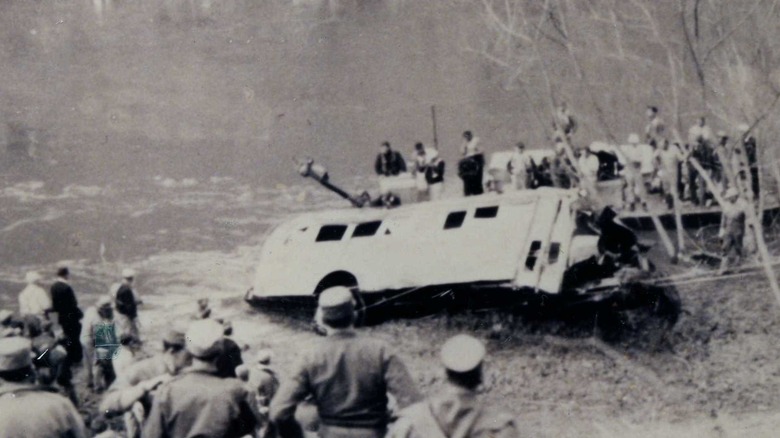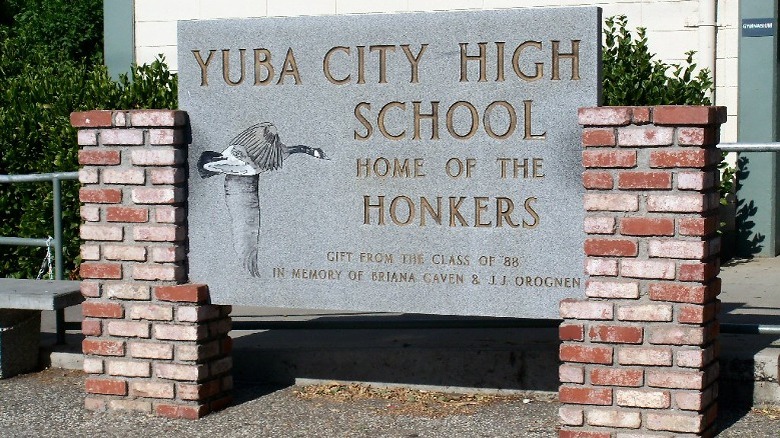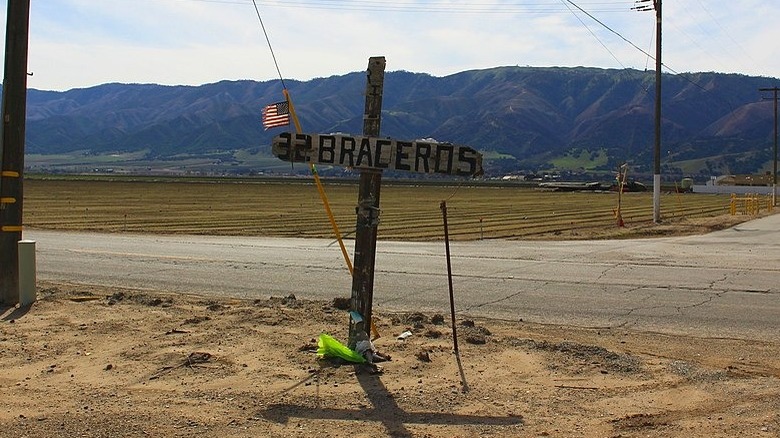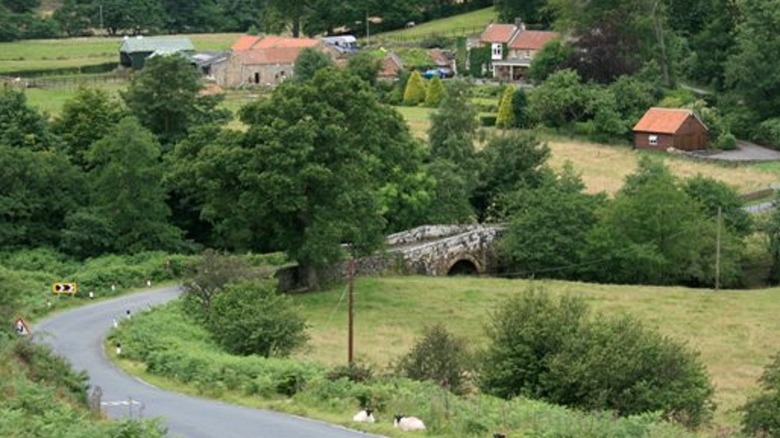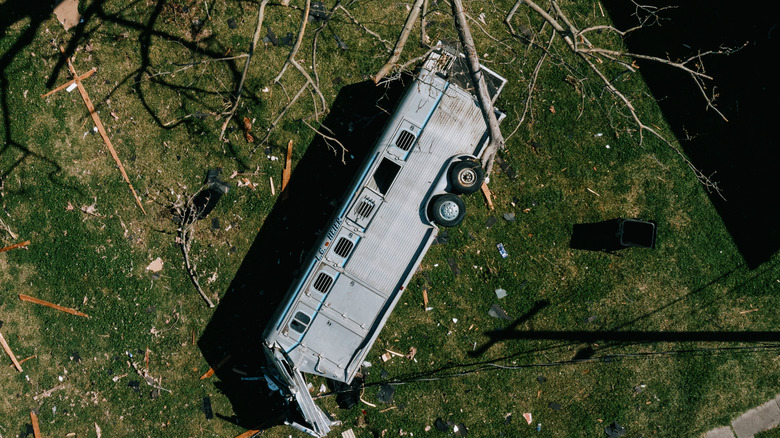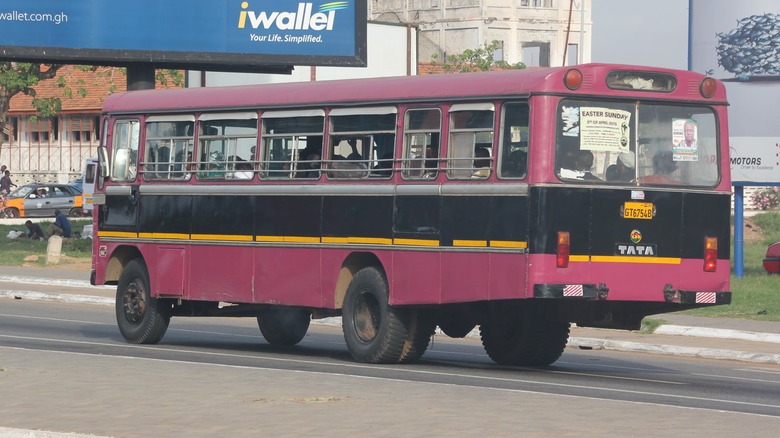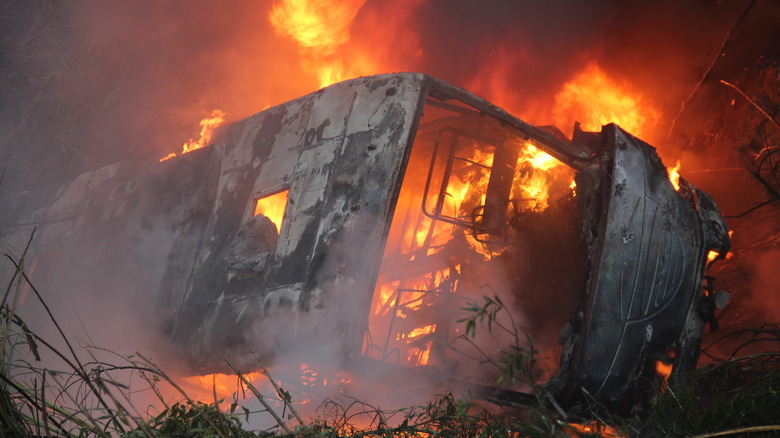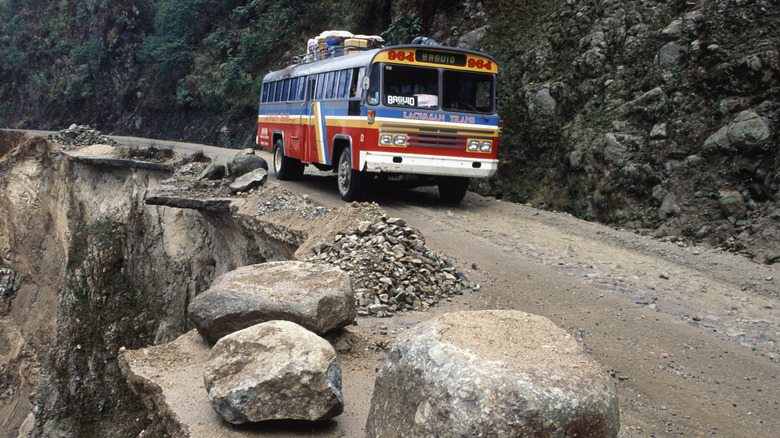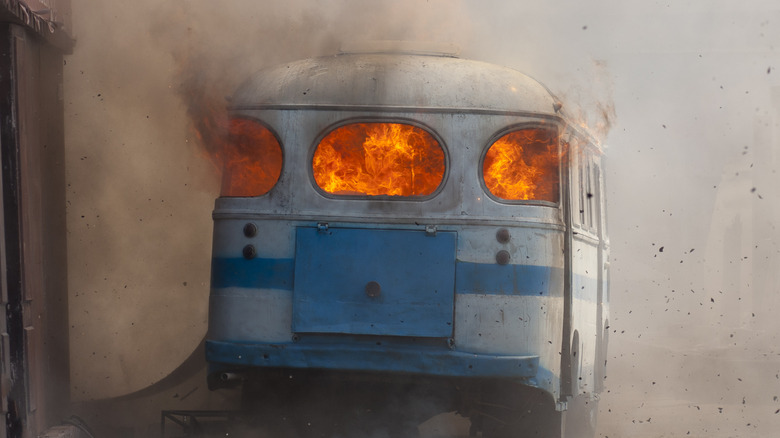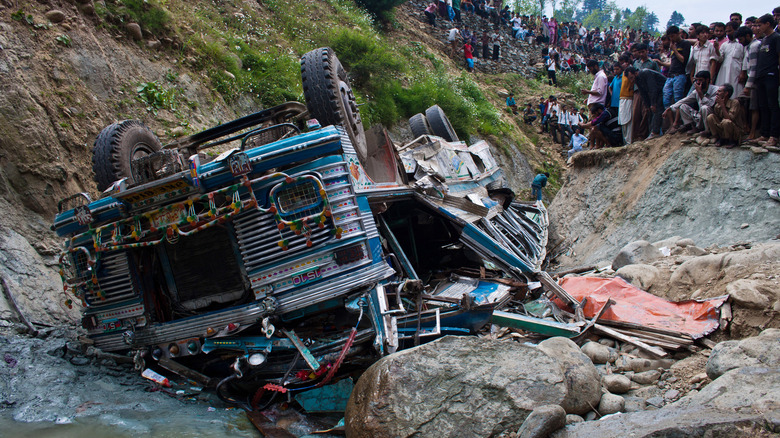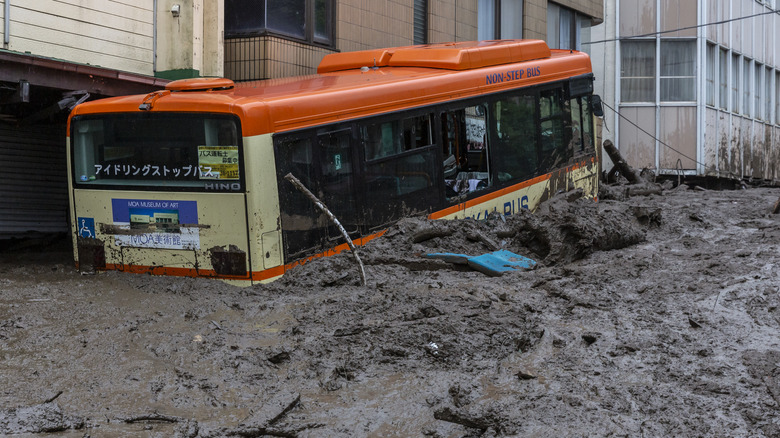The Deadliest Bus Accidents Ever
Buses are possibly the most efficient means to transport large numbers of people over roadways but also one of the deadliest. This is because of their size. For example, a large-ish New York City bus that is articulated (these are the ones that are divided into segments with a bendable middle), can reach about 60 feet in length and carry up to 115 people. The Democratic Republic of Congo has articulated DAF Super CityTrain buses which reach 106 feet in length and can carry 350 passengers.
Because of the volume of humanity that can cram onto a bus, they are prone to high fatality rates when they get into accidents. Yet, some of the deadliest bus accidents only make a blip in English language sources. For example, the text "Introduction to International Disaster Management" cites that in Egypt in 1973, 127 people died when a bus fell into an irrigation canal. Despite the high fatality rate, it only had a brief mention in The New York Times, which cited 70 fatalities (but admitted the actual number of dead was unknown).
However, according to the National Safety Council, buses are by far safer to journey in than passenger cars. It's just that when things do go bad on a bus, they do so in a very dramatic way. Here are some of the deadliest bus accidents from around the world.
New Orleans, Lousiana
Mother's Day is supposed to be a day of celebration and love, but on the morning of May 9, 1999, the holiday took a tragic turn in the worst roadway accident in the history of Louisiana.
A bus packed with elderly women was traveling to Casino Magic in Bay St. Louis, Mississippi. While the vehicle was on Interstate 610 it shifted suddenly from the left to right lanes. It slammed into a guardrail and fell into a tunnel of a golf course. The crash caused 22 deaths and outrage as the next of kin demanded justice.
The bus driver, 46-year-old Frank Bedell, was eyed for potential prosecution. Investigations showed that he had lost two prior driving positions due to failing drug tests. In addition to this, he had heart troubles and was undergoing dialysis. He himself claimed that the accident was caused when a car swerved in front of him on the roadway. However, the case was never fully resolved since Bedell would die that summer. In its findings, the National Transportation Safety Board found that the driver may have been impaired or impacted by his medical conditions. It also showed that there were substances in his bloodstream which may have impaired his driving.
Gillingham, UK
On the evening of December 4, 1951, a company of 52 Royal Marines Cadets was walking from their barracks in Gillingham, U.K. The boys, aged between 9 and 13, were on their way to see a boxing match at the Chatham Docks. At the same time, a double-decker bus driven by John Sampson negotiated its way on the poorly lit streets.
The bus neared the cadets as they walked down a sidewalk of a narrow road with a high wall upon one side. Sampson did not see the cadets, who were dressed in dark blue uniforms, until it was too late. His bus rammed into the back of the line of boys mowing them down. Seventeen died at the scene and another seven within a few hours.
At the inquiry which followed Sampson testified he did not see the cadets at all but thought that he had hit stones when he collided with the boys. It seems that he only stopped the bus when he started to hear screams from the roadway. He was found guilty of accidental death, fined £20, and barred from driving for three years. The parents of the victims were given £10,000 from the bus company and the government moved to make the streets better lit. Since the tragedy, the U.K.'s service branches instituted a rule that columns marching on dark roads at night would have a red light at the rear of the column.
Carrollton, Kentucky
On May 14, 1988, 67 people — mainly teenagers from the First Assembly of God of Radcliff, Kentucky — were traveling in a converted school bus that was returning from an outing at Kings Island, an amusement park near Cincinnati. As the bus was making its way through a curvy stretch of Interstate 71 near Carrollton, Kentucky, 34-year-old Larry Mahoney drove his pickup truck onto the highway in the wrong direction.
The truck collided with the bus, which immediately started to go up in flames as its gas tank was compromised. The passengers pushed at windows to escape the death trap which ultimately took the lives of 27 people including the bus driver. Some of the victims were so unrecognizable that it would take weeks to identify the bodies. Mahoney himself was hospitalized in critical condition.
In the investigation which followed it was found that Mahoney had been intoxicated at twice the legal limit. Because of the ghastly nature of the tragedy he was originally charged with capital murder. Instead, he was eventually convicted on 27 counts of second-degree manslaughter and was sentenced to 16 years behind bars. He would serve 10. The Courier-Journal has reported that since his release, groups dedicated to fighting driving under the influence have tried to contact Mahoney to speak out against drunken driving. He has, however, chosen to remain silent.
Prestonsburg, Kentucky
The Prestonburg Bus Disaster was particularly tragic because the victims were mainly schoolchildren. February 28, 1958 saw an overcast morning with inclement conditions after a storm that brought on a thaw. A school bus loaded with 48 children ranging from elementary to high school students was traveling along U.S. 23. Meanwhile, Donald Horn was driving a wrecker truck and pulled over to investigate a vehicle that was in a ditch. The bus driver apparently did not see Horn's truck in time. It struck the wrecker and then slid down an embankment into the Levisa fork of the Big Sandy River.
Despite the river's waters being high due to the storm, 22 students managed to get out of the bus and to safety by breaking windows and fighting their way out through the back door followed by swimming to the riverbanks. However, the bus became quickly submerged and 26 others were drowned along with the bus driver. The Kentucky National Guard sent 500 personnel to assist with the rescue efforts. One officer recalled (via the state's report on the 50th anniversary), "I remember the bus was loaded with mud and you could see hands and legs sticking out of the mud." The bus was only pulled from the river 55 hours later after it was located by Navy divers 250 feet from where it first plunged into the river.
[Image by Kentucky National Guard Public Affairs Office via Wikimedia Commons | Cropped and scaled | CC BY 2.0]
Martinez, California
The Yuba City Bus disaster is one of the most tragic imaginable. On May 21, 1976, the Yuba City High School sent 52 people from their choir program on a charter bus to a singing program at Miramonte High in Orinda, California.
It seemed what happened was that the driver confused a brake warning light with an oil pressure light. The driver started to exit the highway, but as he attempted to negotiate the turn on the elevated ramp, the brakes gave out and the bus slammed through a guard rail. It dropped off the ramp and flipped onto its roof. A total of 29 people were killed: 28 students and the choir director's wife.
One direct result of the disaster was that it led to more stringent requirements for bus drivers, since it was held that the bus driver in the accident, Evan Prothero, was too inexperienced. In addition, the dangerous highway exit was improved. As for the driver, he was investigated for potential vehicular manslaughter charges, but it was determined there was insufficient evidence to formally charge him. Multiple memorials for the Yuba City Bus Disaster were established and services are held yearly.
Chualar, California
The deadliest bus accident in the United States occurred on September 17, 1963, when an ill-fated bus met a train in Chualar, California. At the time, due to labor shortages Mexican agricultural laborers, called "braceros" were recruited and sent to the Salinas Valley and other locations to work on farms on makeshift buses that have been described as converted flatbed trucks with metal walls. Generally, these laborers were discriminated against and maltreated.
When one of the makeshift buses was transporting workers across some train tracks, it was struck by a Southern Pacific freight train. According to the government's investigation, the crossing, which was on a private road, had no markers. In addition, the bus driver stated he did not hear or see anything unusual. Of those on the bus, 32 were killed and 25 injured. The driver, who survived the crash, was roundly criticized for negligence in the outrage which followed.
Even though the scope of the tragedy made it the deadliest road accident in U.S. history, no memorial was dedicated to the victims until decades later, in 2013, when a portion of Highway 101 was named the Bracero Memorial Highway.
[Image by Elnogalense via Wikimedia Commons | Cropped and scaled | CC BY-SA 4.0]
Dibbles Bridge, England
The deadliest bus tragedy in the history of the United Kingdom occurred at the Dibbles Bridge in North Yorkshire (pictured) on May 27, 1975. The bus which was rumbling along road B6265 carried 45 mainly elderly women who were on a day excursion from Thornaby-on-Tees to the Yorkshire Dales.
The bus encountered a steep downgrade. Roger Marriott, the substitute bus driver shifted incorrectly which led to a brake failure. The bus approached a sharp turn and missing it smashed through the parapet of the Dibbles Bridge, fell 17 feet, and landed upside down in a garden crushing those within. There were 33 dead which included Marriott who, while still caught in the wreckage, was able to relay what happened before he died. One responder recalled to Yorkshire Live, "I think the main problem was that it was such an old coach. When it had turned upside down the weight of the engine and everything underneath crumbled in on itself and down on the occupants."
The owner of the bus was fined £75 for failing to maintain the brakes properly, which was an insulting consolation and kin to the dead. Efforts to keep alive the memory of the tragedy resulted in the unveiling of a permanent memorial at nearby Thornaby Town Hall in May 2022.
[Image by Mick Garratt via Wikimedia Commons | Cropped and scaled | CC BY-SA 2.0]
Bosnek, Bulgaria
Buses are an excellent means of travel for tourists, especially when they visit foreign countries. That is, until disaster strikes. Such was the case on November 23, 2021, when a busload of tourists were traveling back in a convoy to North Macedonia after visiting Istanbul, Turkey.
At about 2:00 a.m. near the town of Bosnek, just outside of Sophia, Bulgaria, one of the buses crashed into a highway divider. At some point, either before or after, the coach was set ablaze. A few managed to escape through a broken window. It was a traumatic and tortuous experience for the 45 victims who perished. Researchers determined that on the whole, they died from suffocation from the smoke, due to being trapped inside the wreck. It was unclear what the cause of the accident was though it is believed that "human error" may have been the culprit.
Sadly, accidents are all too common in Bulgaria. Euronews reporting on European Commission data says the country had the second-highest road fatality rate in the European Union in 2019.
Kintampo, Ghana
On the night of February 17, 2016, a passenger bus loaded with over 80 people was on its normal 242-mile route from Kumasi to Tamale in the West African country of Ghana when disaster struck. The brakes on the bus were faulty and it slammed head-on into a cargo truck loaded with tomatoes near the town of Kintampo. One local journalist arrived at the shocking scene and said (via CNN), "The collision was so intense, you could see the truck almost inside the bus. They were meshed together."
Unfortunately, the bus was well over capacity, being designed to seat 50 people. Reuters reported that witnesses called the collision "pathetic and gory" with "human bodies strewn around." Thankfully, efforts by medical personnel managed to save a number of people's lives. Still, 71 perished in the tragedy. Of these, it was unclear how many of the five aboard the truck were killed.
Boromo, Burkina Faso
The landlocked country of Burkina Faso was home to one of the grisliest bus accidents in recent memory. In the early hours of the morning on November 15, 2008, near the town of Boromo, a truck hauling sugar collided with a bus carrying dozens of workers who were bound for the nearby Ivory Coast. In the chaotic collision, the two vehicles erupted into flames. A grim scene followed.
Many victims were caught in the wreckage while others were ejected onto the roadside. In total, there were 96 victims of which 66 were fatalities. A court prosecutor who commented on how "gruesome" the scene was to the AFP news agency (via The Nation) added, "There are charred bodies which are still being removed. It's really horrible." It took some time to identify all the remains.
Unfortunately, roadway accidents tend to be a common occurrence in this West African country as the rainy season comes to an end and roads become eroded and washed out.
Cavite, Philippines
When two buses collide near a ravine you can only expect bad results. Such was the case on January 6, 1967, when a large caravan of buses loaded with Catholic pilgrims was en route to the town of Termate in the Philippines' Cavite province. They were headed for a religious site there to attend the Feast of the Three Kings. These buses were described by the UPI (via the Desert Sun) as being "homemade" with canvas tops and open sides where passengers sat on benches. As a result, these vehicles were nicknamed "rolling coffins" since there had been concerns about repeated safety failures.
While the caravan was driving through a winding mountain road the brakes on one bus failed, which led it to slam into the bus in front of it while on a sharp turn. Both then tumbled over the 150-foot precipice. The first landed upside down while the other hit head first. Victims were ejected, littering the ravine's floor. One bus driver in the caravan, who witnessed the accident, stated he "could hear screams and crying from adults and children but I could not see the buses themselves because of the thick growth of trees and bushes below." The final death toll was 84.
Zahedan, Iran
Oncoming fuel tankers and overloaded buses do not mix. Such was the case in Zahedan, Iran in June 2004 when a gasoline tanker collided with a bus near the Pakistani border. Some 114 people were injured and 90 people died horribly in the ensuing fire. According to The Independent, the governor of Zahedan, Haidar Ali Nourai stated, "The disaster is so grave we cannot identify faces and cannot differentiate between corpses."
Apparently, what had happened was that the bus was stopped at a police checkpoint whose function was to inspect vehicles since that roadway was one of the main conduits of illegal drugs into the West. One local politician told the ISNA news agency (via the Times of Malta) that this particular checkpoint used "stone-age methods," which often created traffic jams. The checkpoint also was located on a rather sharp bend in the road. The tanker must have taken the turn too fast and then plowed right into the bus which caused an enormous explosion, and one of the deadliest bus accidents on record.
Karnataka, India
In the state of Karnataka in southern India, a privately owned bus overloaded with an excess of 100 passengers was heading to Malebennur on June 8, 1999. It is unclear exactly what happened, but it is thought that one of the bus's tires burst which caused it to plunge into a lake. Unfortunately, the overcrowding on the bus, which included people who were on the roof and hanging out the back, did little to lessen the death toll. There were an estimated 94 dead recovered by police divers and other rescue workers. At the time, the authorities stated that they would charge the bus driver and the company for overloading the vehicle. It is unclear if this was followed through on.
That year was a grim one for bus accidents in Karnataka since that August a second accident occurred at the religious site of Uchangidurga where a bus, again overloaded with possibly up to 100 Hindu pilgrims, skidded down into a square ritual bathing pool. Four escaped unharmed by jumping off the bus, but many others drowned. For hours into the night, rescue workers dove into the pool without oxygen tanks to bring aid. However, all they brought up were bodies. Cranes were then set on the vehicle to try to physically haul the bus out, but the cables snapped. It is unclear how many people died in this accident, but it may have been over 80.
Gifu, Japan
On August 18, 1968, rains from a typhoon had swollen the Hida River in Japan's Gifu prefecture into a muddy mass. Water levels reached up to 30 feet making for dangerous conditions. Meanwhile, a 15-bus caravan filled with sightseers was making its way along the road near the river.
At about 1:20 a.m. the caravan was about to return to Nagoya after visiting Mount Norkura when an adjacent hillside gave way. In the landslide that followed, two of the buses were carried off into the swiftly flowing river. One of the drivers and two passengers managed to swim to the shore but for the rest, it was a death trap. According to The New York Times, the surviving driver stated, "My bus went down into the muddy stream, but somehow I got away through the windshield."
Rescue crews, comprised of about 1,000 workers, immediately located 28 bodies many miles downstream from the site. Yet the conditions were so adverse the large buses could not initially be located. The final death count was a shocking 102 fatalities.
